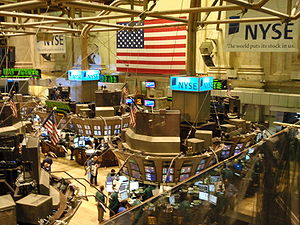 Image via WikipediaAfter tumbling below 10,000 yet again Wednesday morning, the Dow rebounded to close above that psychologically important level and was slightly higher early Thursday. Still, fear in the market is being expressed by the continued rally in Treasuries and widespread chatter about an ominous sounding technical indicator: The Hindenburg Omen.
Image via WikipediaAfter tumbling below 10,000 yet again Wednesday morning, the Dow rebounded to close above that psychologically important level and was slightly higher early Thursday. Still, fear in the market is being expressed by the continued rally in Treasuries and widespread chatter about an ominous sounding technical indicator: The Hindenburg Omen.The Hindenburg Omen has a roughly 25% accuracy rate in predicting big market upheaval since 1987, meaning it's far from infallible but isn't inconsequential either. The indicator's creator, mathematician Jim Miekka, compares the Hindenburg Omen to a funnel cloud that precedes a tornado in a recent interview with The WSJ. "It doesn't mean [the market's] going to crash, but it's a high probability," he said.
Complex and esoteric even in the world of technical indicators, the Hindenburg Omen is triggered when the following occurs, Zero Hedge reports:
-- The daily number of NYSE new 52-week highs and the daily number of new 52-week lows must both be greater than 2.2% of total NYSE issues traded that day.
-- The NYSE's 10-week moving average is rising.
-- The McClellan Oscillator (a technical measure of "overbought" vs. "oversold" conditions) is negative on that same day.
-- New 52-week highs cannot be more than twice the new 52-week lows. This condition is absolutely mandatory.
These criteria have been hit twice since Aug. 12, prompting Miekka to get out of the market entirely, The WSJ reports. Judging by the recent market action, many others are following suit -- or at least moving in the same direction.
Worry List Lengthens
As Henry and I discuss in the accompanying clip, there are a lot of reasons to be worried right now that having nothing to with The Hindenburg Omen, the "Death Cross", Mercury being in retrograde or myriad other indicators cited by market pundits of various stripes.
More fundamental reasons to be concerned include:
It's the Economy, Stupid: This week's weak durable goods and home sales reports are just the latest in a string of desultory data. In sum, the macroeconomic data strongly suggest the job market isn't going to improve anytime soon. And if the job market doesn't improve, there's really not much hope for a turnaround in housing, consumer sales or anything else really. Oh, and the stock market is still expensive on a cyclically adjusted P/E basis, making it more vulnerable to an economic slowdown.
Unusual Uncertainty: On July 21, Fed chairman Ben Bernanke testified on Capitol Hill that the Fed's forecast called for real GDP growth of 3%-3.5% for 2010 and 3.5%-4.5% in 2011 and 2012. Less than a month later, the Fed announced plans to buy Treasuries again (a.k.a. "QE2") and, as The WSJ reported this week, there's a tremendous amount of dissention within the Fed about the 'right' policy prescription.
Financial Follies: Whether it's renewed concerns about Europe's sovereign debt crisis, more U.S. bank closures or reports of commercial developers walking away from properties, it's clear the problems in the financial system were not resolved by various and sundry bailouts and government stimulus ... not by a long shot.
Good Politics vs. Good Economics: S&P's downgrade of Ireland's debt and Greece's revenue shortfall show the short-term perils of the austerity measures that have swept Europe. But promising to cut government spending and slash deficits appears to be a winning political strategy in America right now. Certainly, it's a key message of Republican and Tea Party candidates, who appear to have the momentum heading into the November mid-term elections. But if Europe's 'PIIGS' are any example, gridlock might not be so "good" for the economy this time around, much less the financial markets.
Of course, the "good" news here is that there's so much to worry about and the markets typically are darkest just before dawn.
Aaron Task
August 25, 2010

No comments:
Post a Comment